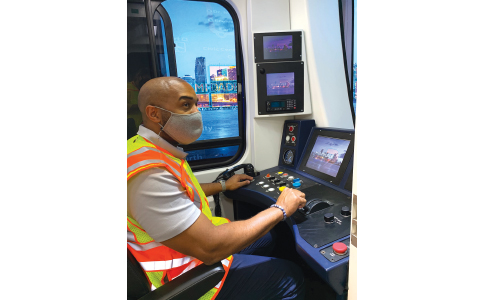Bonanza may raise Miami-Dade Transit federal funding by 24% to 30%

Funds directed to Miami-Dade transit projects from the Infrastructure Investment and Jobs Act will increase federal formula transit funds 24% to 30% and the county will still compete for additional money through grant programs, Eulois Cleckley, director of the Department of Transportation and Public Works, (DTPW) told Miami Today.
The funds are to be used to finance the department’s existing programs and operations, but also for new initiatives such as the Smart Plan’s rapid transit corridor additions and electric vehicle charging expansion.
A fact sheet from the White House says Florida could get $245 million for bridge replacement and repairs, and $2.6 billion over five years to improve public transportation across the state.
Mayor Daniella Levine Cava told Miami Today in a previous interview that she had knowledge that the State of Florida had assigned around $240 million for major transportation projects. “That’s not a lot of money all around the state,” she said.
DTPW would use the dollars coming from the formula grants for programs the department already has such as planning, engineering and design of transit; doing additional studies; looking at capital investments within the county’s bus fleet; fixing the current Metrorail, Metromover or bus system; and improving the communications, technology and computer hardware and software across all of those systems.
Those are the types of activities that typically get paid for in the formula funding grant programs the county currently has, Mr. Cleckley explained.
“We feel that we have plenty of projects and activities that would be competitive and be eligible to receive additional dollars, but the only funds that we know that we will have an increase in is our existing grant programs,” he said.
The new act lists new infrastructure programs related to safety. Miami-Dade has a program called Vision Zero to set up safety measures to reduce, and ultimately eliminate, fatalities and serious injuries related to mobility, the website of the program details.
Also, from the traditional capital investment programs, certain corridors of the Smart Plan could compete for funds. DTPW is working to find the opportunities within the existing framework of the infrastructure bill to submit the “proper types of projects to hopefully be very competitive and get future funding,” Mr. Cleckley said.
“We are aggressively working to help the federal government to allow this new funding and these new programs to be able to go directly to the county,” he said.
The document from the White House says Florida could expect to receive $198 million spread over five years to support the expansion of an electric vehicle charging network and the opportunity to apply for the $2.5 billion in grants dedicated to electric vehicle charging in the act.
The county currently doesn’t have a final program to address the expansion of the electric vehicle charging stations, but “the infrastructure bill is going to allow us the opportunity to develop that strategy and figure out what the funding options are moving forward,” said Mr. Cleckley.
Commissioner Raquel Regalado presented a resolution for the Dec. 1 county commission meeting directing the Mayor’s Office to advise the commission of the number and location of electric vehicle charging stations within county facilities and to reevaluate and update a 2016 Miami-Dade County plan to install the charging stations.
While it is still uncertain how much federal funding the county would get, the transit department currently has a Capital Investment Program toward the next five years budgeted at about $5.5 billion and the Smart Plan costs around $7 billion, Mr. Cleckley said.
“There’s always going to be a level of projects that we currently will not have funding for over an extended period of time, so the infrastructure bill is fantastic because it starts to inject those additional funding sources to be able to help us implement projects that are currently underfunded or currently not funded,” he said.
With better infrastructure, property values could increase, and redevelopment opportunities should become more available due to a provision in land use regulation called concurrency, Louis Archambault, real estate attorney and partner at Saul Ewing Arnstein & Lehr, told Miami Today.
“You’ll have the ability for more water and sewer capacity [and] better roads,” Mr. Archambault said. “So, a property that may not have been able to be redeveloped because you don’t have a sufficient level of concurrency around the property, if you’re able to increase that by repairing and replacing the infrastructure around the property, now that property’s a viable redevelopment property because of the added infrastructure.”
Mr. Archambault acknowledged that there is “never going to be enough funding” to pay for all the projects the state and local government may want to finance with the federal funds. But, he said, “it is a process of the governments themselves to be able to allocate the resources based on what they feel is the best priority for the funds.”







Recent Comments